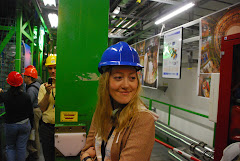Hello sundry folk! To put an end to the near-criminal level of neglect I've shown this blog, let me give an update. The most important news is that I survived the fall quarter of the SciComs program (along with my
nine SciComrades). There was some gnashing of teeth and wailing. But overall I think my molars are in good shape. I haven't made an appointment to see a dentist yet at least.
We start again January 4, and will work on features and profile writing. But we've not been idle during the break. As proof let me share what I've been writing during the last few weeks.
Most of us were at the American Geophysical Union meeting in San Francisco last week. This was an astronomically-sized meeting of ground-shaking, world-exploring, climate-modeling, fossil-uncovering research. We were paid bloggers and, while fun, this was a little rough. We needed to turn the posts around quickly and we were covering subjects that were far removed from our academic fields. We had little time to speak to the researchers (if we had any). But what doesn't kill you will either give you indigestion or make you stronger.
A little collection of my posts for you, starting with the most recent first:
Between sessions last Friday, I hope you visited the exhibition hall one last time. Past the jewelery stands selling fossils and geodes and booths selling maps and drilling equipment, you may have spotted a minor celebrity–a little machine famous for great science.
No sooner did I wish for a 3D movie at AGU, than I got one.
In February, NASA launched the Solar Dynamics Observatory (SDO), an Earth-orbiting spacecraft, dedicated to investigating the Sun and it’s effect on Earth and space weather.
I also wrote a story for the newspaper based on a NASA press release at AGU.
Growers in the Salinas and San Joaquin valleys are about to get help from above.
More excitng news-paper related updates coming tomorrow!






